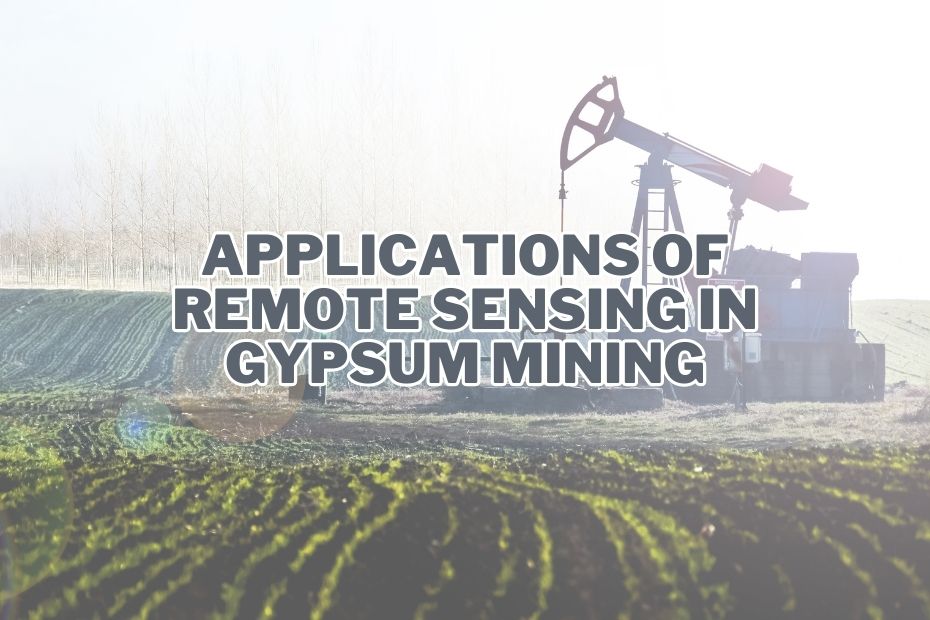Mining operations have greatly benefited from technological advancements, and one such innovation is remote sensing. When it comes to gypsum mining, remote sensing has proven to be an invaluable tool, offering numerous applications that enhance efficiency, safety, and sustainability. In this article, we will explore some fascinating application of remote sensing in gypsum mining.
Remote sensing in gypsum mining offers a wide range of applications, including geological surveys and deposit identification. It aids in monitoring environmental impact, ensuring safety, and optimizing resource management. From tracking equipment to detecting illegal mining, remote sensing revolutionizes the mining industry with efficiency and sustainability.
Application of Remote Sensing In Gypsum Mining
In the mining industry, technological advancements have significantly improved various processes, and one such revolutionary tool is remote sensing. Utilizing satellite or airborne sensors to capture data about the Earth’s surface, remote sensing plays a crucial role in gypsum mining operations.
1. Geological Surveys and Mapping
Accurate geological surveys and mapping are fundamental for successful gypsum mining operations. Remote sensing offers geologists a valuable tool to gather detailed information about the terrain, mineral composition, and potential gypsum deposits. By employing multispectral and hyperspectral sensors, geologists can identify unique spectral signatures of gypsum, distinguishing it from other minerals, thereby streamlining the exploration process and reducing costs.
2. Identification of Gypsum Deposit
The identification of gypsum deposits is a critical step in mining planning. Remote sensing technologies allow geologists to identify and map gypsum occurrences over vast areas quickly. This aids in selecting the most suitable sites for mining operations, ensuring optimal resource utilization.
3. Monitoring Land Use and Environmental Impacts
Mining activities can have significant environmental impacts. Remote sensing facilitates continuous monitoring of land use changes and environmental impacts caused by gypsum mining. This data helps in assessing the effectiveness of environmental management plans and implementing necessary corrective measures to mitigate negative effects.
4. Assessment of Stability and Safety
Safety is a primary concern in mining operations. Remote sensing techniques, such as Interferometric Synthetic Aperture Radar (InSAR), enable the monitoring of ground stability and potential hazards like subsidence. Continuous monitoring of mine sites helps prevent accidents and ensures the safety of personnel and equipment.
5. Topographical Analysis
Accurate topographical data is crucial for mine planning and design. Remote sensing technologies provide high-resolution elevation models and topographic maps, aiding engineers in developing efficient mining strategies and infrastructure layouts.
6. Monitoring of Stockpiles
Gypsum stockpile management is essential for maintaining a steady supply chain. Remote sensing assists in real-time monitoring of stockpile volumes and movements, optimizing inventory management and minimizing wastage.
| BENEFITS | DESCRIPTION |
|---|---|
| Efficient Resource Management | Remote sensing optimizes the allocation of resources, reducing unnecessary expenses and maximizing profits. |
| Improved Environmental Compliance | By monitoring environmental impacts, companies can adhere to regulations and improve their public image. |
| Enhanced Safety Measures | Continuous monitoring ensures the safety of workers and equipment, preventing accidents and associated costs. |
| Streamlined Planning and Operations | Remote sensing data aids in efficient mine planning and decision-making processes. |
| Better Predictive Models | Utilizing historical data and remote sensing information, companies can create accurate predictive models for future mining prospects. |
7. Water Resource Management
Water is a valuable resource in mining, and its efficient management is crucial. Remote sensing enables the assessment of water availability and quality, allowing mining companies to implement sustainable water management practices.
8. Detection of Illegal Mining Activities
Illegal mining poses a significant threat to both the environment and the mining industry. Remote sensing technology aids in detecting and monitoring unauthorized mining activities, helping authorities take appropriate actions to prevent such activities.
9. Tracking Equipment and Assets
In large-scale mining operations, keeping track of equipment and assets is challenging. Remote sensing, combined with GPS technology, provides real-time tracking and management of equipment, ensuring their proper utilization and reducing the risk of theft.
10. Monitoring of Vegetation and Biodiversity
Mining activities can impact local ecosystems. Remote sensing assists in monitoring vegetation changes and biodiversity loss, enabling proactive conservation efforts.
11. Environmental Compliance and Reporting
Regulatory compliance is paramount in the mining industry. Remote sensing data facilitates accurate reporting of environmental conditions, simplifying compliance procedures.
12. Predictive Modeling and Forecasting
Remote sensing data, combined with historical mining data, aids in creating predictive models and forecasts for future mining operations. This assists mining companies in making informed decisions and strategic planning.
Conclusion:
The application of remote sensing in gypsum mining are diverse and far-reaching. From aiding in geological surveys and identifying gypsum deposits to ensuring environmental compliance and predictive modeling, this technology revolutionizes the mining industry. By leveraging the power of remote sensing, mining companies can enhance safety, optimize operations, and contribute to sustainable mining practices.
FAQs: Application of Remote Sensing In Gypsum Mining
How does remote sensing help in gypsum mining?
Remote sensing aids gypsum mining through geological surveys, identifying deposits, monitoring environmental impact, ensuring safety, and enhancing resource management.
Can remote sensing detect illegal mining activities?
Yes, remote sensing can detect illegal mining activities by providing real-time data on mining operations, helping authorities take necessary actions.
How does remote sensing contribute to environmental preservation?
Remote sensing assists in monitoring land use changes, vegetation, and water resources, enabling the implementation of sustainable practices and environmental preservation.
What role does remote sensing play in predicting mining risks?
By integrating remote sensing data with advanced analytics, predictive modeling helps assess mining risks and enhances decision-making and resource planning.
How does remote sensing optimize stockpile management in gypsum mining?
Remote sensing allows real-time monitoring of stockpile volumes, ensuring efficient inventory management and preventing stockpile overflow.
